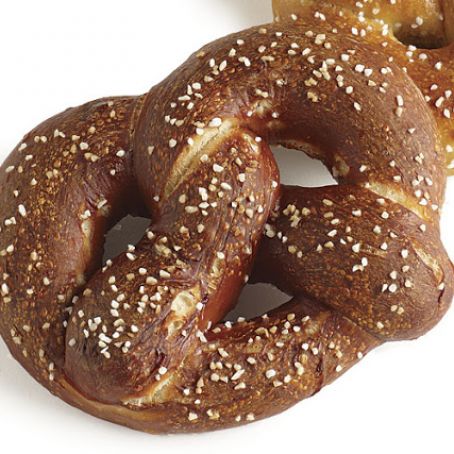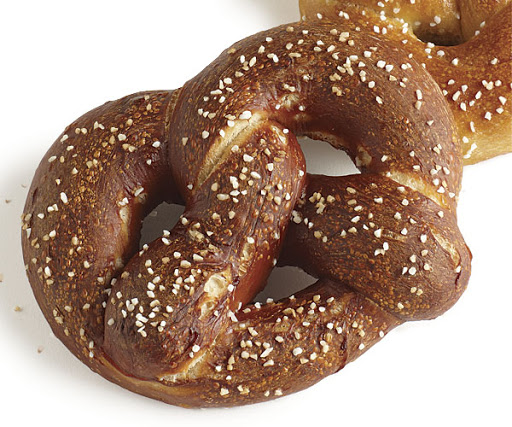Bavarian-Style Soft Pretzels
By garciamoss
An oil mister comes in handy because it releases less oil than a can of cooking spray does. Whichever you use, mist only as necessary to prevent the dough from sticking or drying out; too much will make the pretzels greasy.
 1 Picture
1 Picture
Ingredients
- 1-1/2 tsp. active dry yeast
- 19-1/2 oz. (4-1/2 cups) unbleached bread flour; more as needed
- 2 Tbs. packed light brown sugar
- 1 Tbs. vegetable oil
- 2-1/4 tsp. kosher salt
- Oil mister filled with vegetable oil (or cooking spray)
- 1-1/2 Tbs. food-grade lye microbeads, or 3 Tbs. baking soda
- 1 large egg, lightly beaten (only if using baking soda instead of lye)
- 1 Tbs. pretzel or coarse salt
Details
Adapted from finecooking.com
Preparation
Step 1
Tip:
A few key ingredients will help you make excellent pretzels at home. Food-grade lye microbeads are essential for a flavorful, mahogany-brown crust (you can also use baking soda, but the results won’t be the same). Pretzel salt is a bright white compressed salt that adheres well to the unbaked dough; kosher or coarse sea salt is a good substitution.
n a stand mixer fitted with the dough hook (or in a large mixing bowl with a whisk), combine the yeast and 1-1/2 cups lukewarm (90°F to 95°F) water and let stand until dissolved, about 5 minutes. (The mixture should smell yeasty. If it doesn’t, start over with a fresh batch of active dry yeast.) Add the flour, sugar, oil, and salt. Mix on low speed (or with a wooden spoon) until the ingredients are hydrated and form a coarse ball of dough, 2 to 3 minutes. Add more water as needed, 1 tsp. at a time, if all of the flour is not incorporated into the dough.
Increase the speed to medium low and mix (or transfer the dough to a work surface misted with oil and knead by hand) until the dough becomes smooth, supple, and elastic, about 3 minutes. The dough should be soft but only slightly tacky; if it seems sticky or very tacky, sprinkle in more flour, as needed. If using a stand mixer, transfer the dough to a lightly oiled work surface and knead by hand for a few more seconds. Form the dough into a ball, transfer to a large, lightly oiled bowl, cover with plastic wrap, and let rise at room temperature until it’s about 1-1/2 times its original size, 1 to 1-1/2 hours.
Lightly mist a work surface with oil and transfer the dough to it. Divide the dough into 6 equal pieces (about 6 oz. each). Form each piece into a smooth, round ball, lightly mist with oil, and cover with plastic wrap; let rest on the work surface at room temperature for 20 to 30 minutes to allow the gluten to relax.
Shape the pretzels
Line a large baking sheet with lightly oiled parchment or a silicone baking mat and set aside.
Lightly mist a work surface and, using your palms and fingers, roll each piece of dough on the work surface into a rope that’s about 30 inches long and 1/3 to 1/2 inch thick. If the dough resists or shrinks back, let it rest for a few minutes while you work on other pieces; short rests will let the gluten relax enough to allow for the full rollout.
Working with 1 dough rope at a time, shape it into a large U that’s 5 to 7 inches across with the curve closest to you. Take the 2 ends of the rope in your fingers and cross one over the other so the ends overhang the cross by about 3 inches. Twist the ends of the rope, shortening the overhang to about 2 inches. Next, pull the twisted end section toward you and fold it down over the bottom curve of the U so the ends are a couple of inches apart and overhang the bottom by about 1/4 inch.
Carefully transfer the pretzels to the prepared baking sheet, spacing them evenly and reshaping as needed. Cover with plastic wrap and freeze until hard, at least 2 hours and up to 3 weeks.
Dip the pretzels
If using lye, put on protective gloves. Pour 2 cups cool water into a small stainless-steel bowl just wide enough to hold one pretzel.
Add the lye and stir with a stainless-steel whisk or spoon until completely dissolved.
If using baking soda, bring 2 cups water to a boil in a small saucepan. Remove from the heat, add the baking soda, and stir until completely dissolved. Transfer to a bowl and let cool to lukewarm, about 30 minutes.
Using stainless-steel tongs or a stainless-steel slotted spoon, dip one pretzel at a time in the lye (or baking soda) bath and soak for 5 seconds. If the liquid doesn’t completely cover the pretzel, turn it over and submerge the other side for 5 seconds. Remove the pretzel from the liquid, allowing the excess to drip off, and return it to the baking sheet. To discard the lye bath, slowly pour it down the sink drain and flush with cool running water for a few seconds. If you wore non-disposable gloves, wash them in cool soapy water and rinse well. If you used a baking soda bath, brush the tops and sides of the pretzels with some of the beaten egg.
Let the pretzels thaw and rise at room temperature until they are soft and puffy, 1-1/2 to 2 hours.
Bake the pretzels
Position a rack in the center of the oven and heat the oven to 400°F. Brush baking-soda-dipped pretzels once more with egg.
Lightly sprinkle the pretzels with the salt. Set the baking sheet of pretzels on another baking sheet (double-pan them) to prevent the bottoms of the pretzels from browning too quickly. Bake, rotating the pan halfway through, until rich, deep mahogany-brown for lye-dipped pretzels or dark golden-brown for baking-soda-dipped pretzels, 20 to 22 minutes. Transfer the pretzels to a rack and cool for at least 15 minutes before serving.

Review this recipe